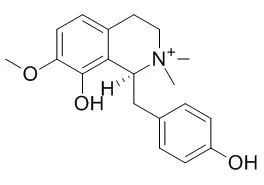| Description: |
Oblongine chloride may have potential haemodynamic effects, it can cause a dose-dependent reduction of systolic and diastolic blood pressure, and that these effects are not mediated by β-adrenergic receptor stimulation. |
| In vitro: |
| Gen Pharmacol. 1993 Mar;24(2):299-304. | | Effects of oblongine chloride, an alkaloid from Leontice leontopetalum on guinea-pig isolated smooth muscle and heart.[Pubmed: 8482513] | 1. The effects of (-)Oblongine chloride, a quaternary alkaloid from Leontice leontopetalum, on guinea-pig isolated ileal longitudinal segments, main pulmonary artery rings, spontaneously-beating atrium and isolated perfused heart were studied.
METHODS AND RESULTS:
2. Oblongine chloride (3 x 10(-5)-10(-3) M) caused concentration-dependent relaxation of ileum, an effect which was not blocked by propranolol (10(-6) M) alone or in combination with prazosin (3 x 10(-8) M), or by indomethacin (10(-6) M), but was reduced by desensitization of the preparation by prior exposure to 3 x 10(-5) M ATP and, at high concentrations of Oblongine, by a combination of propranolol and yohimbine (3 x 10(-6) M). 3. Oblongine chloride (10(-5)-3 x 10(-3) M) caused concentration-dependent relaxation of epinephrine-precontracted pulmonary artery. This effect was not affected by propranolol or by indomethacin but was significantly attenuated by pretreatment with 3 x 10(-5) M ATP and potentiated by pretreatment with quinacrine (10(-5) M). 4. Oblongine chloride (10(-5) M-3 x 10(-3) M) caused concentration-dependent increase in the contractility but did not affect the rate of the atrium. Similar effects were obtained with isolated perfused heart except that large concentrations of Oblongine (10(-3), 3 x 10(-3) M) inhibited both contractility and rate of the heart.
CONCLUSIONS:
The inotropic effects of Oblongine on the atrium were not blocked by propranolol or indomethacin but were significantly blocked by quinacrine. |
|
| In vivo: |
| Phytother. Res., 1995, 9(1):60-3. | | Cardiovascular effects of oblongine chloride, an alkaloid from Leontice leontopetalum, in the anaesthetized guinea-pig[Reference: WebLink] | The effects of (61)Oblongine chloride, a quaternary alkaloid from Leontice leontopetalum on blood pressure, heart rate and blood flow of the anaesthetized guinea-pig were studied.
METHODS AND RESULTS:
At doses ranging from 0.5 mg/kg to 30 mg/kg, i.v., Oblongine chloride caused a dose-dependent reduction of systolic and diastolic blood pressure. These doses were associated with an increase in heart rate. Propranolol (5 mg/kg) failed to block the effects of Oblongine chloride on systolic and diastolic blood pressure but significantly reduced the increase in heart rate observed with low doses (0.5–6 mg/kg) of Oblongine chloride. In doses ranging from 0.05 mg/kg to 0.5 mg/kg, Oblongine chloride caused a small increase in blood flow. Larger doses (1.5, 4.5, 15 and 30 mg/kg) caused an initial decrease followed by an increase of blood flow. The net effect of cumulative doses was an increase in blood flow over the control value.
CONCLUSIONS:
These observations suggest that Oblongine chloride may have potential haemodynamic effects and that these effects are not mediated by β-adrenergic receptor stimulation. |
|






 Cell. 2018 Jan 11;172(1-2):249-261.e12. doi: 10.1016/j.cell.2017.12.019.IF=36.216(2019)
Cell. 2018 Jan 11;172(1-2):249-261.e12. doi: 10.1016/j.cell.2017.12.019.IF=36.216(2019) Cell Metab. 2020 Mar 3;31(3):534-548.e5. doi: 10.1016/j.cmet.2020.01.002.IF=22.415(2019)
Cell Metab. 2020 Mar 3;31(3):534-548.e5. doi: 10.1016/j.cmet.2020.01.002.IF=22.415(2019) Mol Cell. 2017 Nov 16;68(4):673-685.e6. doi: 10.1016/j.molcel.2017.10.022.IF=14.548(2019)
Mol Cell. 2017 Nov 16;68(4):673-685.e6. doi: 10.1016/j.molcel.2017.10.022.IF=14.548(2019)